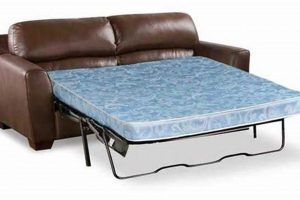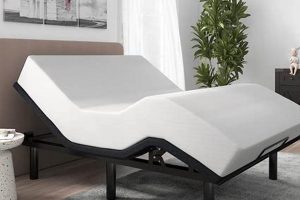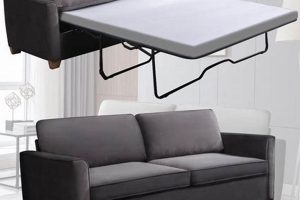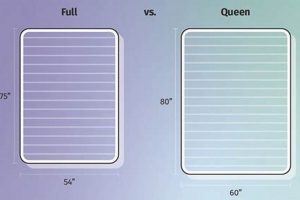A common inquiry when purchasing bedding concerns the dimensional parity between a full and a queen-sized mattress. These two sizes represent distinct options, each catering to specific spatial and occupancy needs. The full size, also known as a double, measures approximately 54 inches in width and 75 inches in length. The queen size, conversely, offers greater surface area, typically measuring 60 inches wide and 80 inches long. This difference in dimensions directly impacts the suitability of each mattress for various bedroom sizes and sleeper preferences.
The selection of an appropriate mattress size is a critical factor in ensuring optimal sleep quality and comfort. The queen size provides increased space, particularly beneficial for couples or individuals who prefer to spread out during sleep. Historically, the full-size mattress was a standard choice for single adults. However, as living spaces have evolved and personal preferences for sleeping space have increased, the queen size has gained prominence due to its enhanced comfort and versatility.
The following discussion will delve deeper into the specific differences between these mattress sizes, examining factors such as suitability for couples, space requirements in the bedroom, the availability and cost of bedding accessories, and the overall comfort level afforded by each option. This detailed analysis aims to provide consumers with the necessary information to make an informed decision regarding their mattress purchase.
Guidance on Distinguishing Mattress Sizes
This section offers practical advice for discerning the differences between full and queen-sized mattresses to facilitate an informed purchasing decision.
Tip 1: Measure Bedroom Space: Prior to purchase, accurately measure the intended bedroom area. Ensure adequate clearance for movement around the bed after accounting for the mattress dimensions and associated furniture.
Tip 2: Consider Occupancy: Evaluate the number of individuals who will be sleeping on the mattress. Queen-sized mattresses are generally better suited for couples due to the increased sleeping surface.
Tip 3: Assess Individual Sleep Preferences: Individuals who prefer ample space or tend to move frequently during sleep may find the additional width and length of a queen-sized mattress more comfortable.
Tip 4: Review Bedding Availability: Ensure that bedding accessories, such as sheets, comforters, and bed frames, are readily available and affordable in the desired mattress size.
Tip 5: Compare Costs: Evaluate the price differential between full and queen-sized mattresses, taking into account the long-term investment and potential impact on sleep quality.
Tip 6: Evaluate Room Aesthetics: A queen-sized mattress may visually dominate a smaller room. Consider the overall aesthetic and balance of the room when selecting a mattress size.
Tip 7: Understand Future Needs: Project future needs, such as potential cohabitation or changes in living arrangements, when choosing between a full and queen-sized mattress. A larger mattress offers more flexibility.
Careful consideration of these points enables a more informed selection, leading to improved sleep quality and overall satisfaction with the mattress purchase.
The subsequent sections will further explore the specific use cases and advantages of each mattress size in various contexts, providing a comprehensive overview of the options available.
1. Dimensions
The physical dimensions of a mattress are paramount in determining its suitability for specific needs and spaces. The variance in dimensions is the foundational difference; the phrase “is a full mattress the same as a queen” becomes intrinsically linked to quantifiable measurements of length and width.
- Width Disparity
A full-sized mattress typically measures 54 inches in width, while a queen-sized mattress measures 60 inches. This six-inch difference directly impacts the available sleeping space, particularly for cohabitating individuals. The increased width provides each sleeper with approximately three additional inches, potentially enhancing individual comfort and reducing disturbances caused by movement during sleep.
- Length Variance
The length also differentiates these mattress types. A full-sized mattress usually has a length of 75 inches, whereas a queen-sized mattress extends to 80 inches. This five-inch difference can be significant for taller individuals. The additional length allows for more comfortable spinal alignment and prevents feet from extending beyond the mattress edge.
- Area Calculation and Room Fit
The overall surface area is a key consideration. The area of a full mattress is approximately 4,050 square inches, while a queen mattress provides roughly 4,800 square inches. This difference informs decisions about fitting the mattress into a bedroom. Smaller rooms may only accommodate a full-sized mattress, while larger rooms can comfortably house a queen-sized option, allowing for greater freedom of movement and furniture placement.
- Impact on Bedding Selection
Mattress dimensions dictate the required size of bedding accessories. Sheets, comforters, and bed frames must be appropriately sized to fit the specific mattress dimensions. The dimensional divergence between full and queen mattresses necessitates separate bedding purchases, influencing overall cost and availability.
These dimensional factors underscore the critical differences. The explicit measurements of each mattress size dictate its appropriateness for specific bedroom sizes, individual height, co-sleeping arrangements, and bedding requirements, effectively addressing the implicit question within the phrase “is a full mattress the same as a queen.”
2. Sleeping Space
The amount of available sleeping space provided by a mattress directly influences sleep quality and overall comfort. Evaluating the disparities in sleeping space between mattress sizes is essential when determining whether “is a full mattress the same as a queen” is a relevant inquiry for individual needs.
- Individual Occupancy
A full-sized mattress, with its 54-inch width, offers adequate sleeping space for a single adult. However, individuals who prefer more expansive sleeping arrangements or those who tend to move frequently during sleep might find the confines restrictive. A queen mattress, at 60 inches wide, provides additional space, promoting greater comfort and reducing feelings of constraint. The question of sufficient individual space underscores the initial consideration of whether “is a full mattress the same as a queen” matters to a single sleeper.
- Dual Occupancy
The suitability of a mattress for couples hinges significantly on the available sleeping space. A full-sized mattress provides each sleeper with only 27 inches of width, a space considered less than ideal for comfortable co-sleeping. A queen-sized mattress offers 30 inches per person, affording a marginal but potentially impactful increase in personal space. For couples, the question of whether “is a full mattress the same as a queen” becomes critical, as the larger mattress directly addresses the need for increased individual sleeping area.
- Motion Transfer and Disturbance
Limited sleeping space can exacerbate the effects of motion transfer. When space is restricted, movements by one sleeper are more likely to disturb the other. A larger sleeping surface, such as that offered by a queen-sized mattress, can mitigate this issue by providing greater separation between individuals, thereby reducing the impact of motion transfer. The concern about minimizing sleep disturbance informs the consideration of whether “is a full mattress the same as a queen” holds relevance for those sharing a bed.
- Edge Support Utilization
The effective sleeping space is also influenced by the quality of edge support. Mattresses with weak edge support may exhibit significant compression near the perimeter, reducing the usable sleeping surface. This phenomenon disproportionately affects smaller mattresses, such as full-sized options, where the available space is already limited. Strong edge support, conversely, maximizes the usable sleeping surface. The importance of edge support to sleeping space highlights the practical implications of determining whether “is a full mattress the same as a queen” relative to specific mattress construction.
The assessment of sleeping space requirements is a pivotal element in the mattress selection process. The adequacy of space, both for individual and dual occupancy, directly impacts sleep quality and overall satisfaction. The disparities in sleeping space between full and queen-sized mattresses ultimately inform the consumer’s understanding of whether “is a full mattress the same as a queen” has practical implications for their unique circumstances.
3. Bedroom Size
The physical dimensions of a bedroom exert a significant influence on the selection of an appropriately sized mattress. The determination of whether “is a full mattress the same as a queen” becomes intrinsically linked to the spatial constraints imposed by the room’s dimensions. The available floor space dictates the practicality of accommodating either a full or a queen-sized mattress.
- Spatial Planning and Traffic Flow
The primary consideration involves the ability to navigate the bedroom comfortably after the mattress and associated furniture are in place. A queen-sized mattress, with its larger footprint, consumes more floor space than a full-sized mattress. If the bedroom is of limited size, the inclusion of a queen mattress may impede traffic flow, creating a sense of confinement and hindering accessibility to other furniture items. The efficient use of space is paramount, rendering the inquiry “is a full mattress the same as a queen” a practical concern for spatial optimization.
- Furniture Placement and Aesthetics
The size of the mattress impacts the arrangement and scale of other furniture pieces within the bedroom. Smaller bedrooms often benefit from the more compact dimensions of a full-sized mattress, allowing for the inclusion of additional furniture, such as dressers, nightstands, and seating, without overcrowding the space. Conversely, a queen-sized mattress may necessitate a more minimalist approach to furniture selection and placement to maintain visual balance and avoid a cluttered appearance. Aesthetic considerations directly influence the decision regarding “is a full mattress the same as a queen.”
- Minimum Room Dimensions
General guidelines suggest minimum room dimensions for accommodating different mattress sizes. For a full-sized mattress, a room measuring at least 10 feet by 10 feet is typically recommended to ensure adequate space for movement. A queen-sized mattress, due to its larger footprint, ideally requires a room measuring at least 10 feet by 12 feet. These minimum dimensions are not absolute but serve as practical benchmarks for assessing spatial feasibility. Compliance with these guidelines informs the relevance of “is a full mattress the same as a queen” in a specific context.
- Perceived Space and Psychological Impact
The perception of space within a bedroom can significantly influence psychological well-being. A crowded and cramped bedroom may induce feelings of stress and anxiety, negatively impacting sleep quality. Conversely, a well-proportioned room with ample space promotes a sense of calm and relaxation. The choice between a full and queen-sized mattress, therefore, transcends mere functionality and extends to the psychological impact of the bedroom environment. The contribution of mattress size to the overall room ambiance highlights the importance of considering “is a full mattress the same as a queen” in relation to personal comfort and mental health.
The interplay between bedroom size and mattress dimensions is a critical factor in ensuring a comfortable and functional sleeping environment. The suitability of either a full or queen-sized mattress is contingent upon a careful assessment of spatial constraints, furniture placement, and aesthetic considerations. Therefore, the query “is a full mattress the same as a queen” demands a nuanced understanding of the room’s dimensions and their implications for overall bedroom functionality and psychological well-being.
4. Bedding Costs
The phrase “is a full mattress the same as a queen” carries significant implications for associated bedding costs. The dimensional disparities between the two mattress sizes directly impact the pricing and availability of appropriately sized sheets, comforters, duvet covers, and bed frames. Full-sized bedding typically commands a lower price point due to the reduced material requirements in manufacturing. Conversely, queen-sized bedding, necessitated by the increased surface area, incurs higher material costs, resulting in elevated retail prices. This price differential extends across a range of bedding accessories, including mattress protectors and decorative pillows. The cumulative effect of these incremental cost differences can contribute substantially to the overall expense associated with outfitting a bed, emphasizing the economic relevance of addressing “is a full mattress the same as a queen.”
Furthermore, the prevalence and market demand for each bedding size influence pricing dynamics. Queen-sized mattresses are increasingly popular, leading to wider availability and, potentially, more competitive pricing for certain bedding items. Conversely, full-sized bedding, while generally less expensive, may offer fewer design choices and limited availability in specialized materials or high-end brands. The selection of a mattress size, therefore, entails a trade-off between initial mattress cost and the long-term expenses associated with procuring and maintaining appropriately sized bedding accessories. For example, a consumer opting for a less expensive full-sized mattress may later discover that high-quality, full-sized sheet sets are less readily available and comparably priced to standard queen-sized sets, diminishing the anticipated cost savings. This underscores the importance of considering the entire ecosystem of bedding costs when determining whether “is a full mattress the same as a queen” holds significant financial implications.
In summary, the economic ramifications of choosing between a full and queen-sized mattress extend beyond the initial purchase price of the mattress itself. Bedding costs represent a substantial ongoing expense, influenced by material requirements, market demand, and availability. Consumers must carefully evaluate the total cost of ownership, encompassing both the mattress and associated bedding, to make a fiscally responsible decision. The understanding that “is a full mattress the same as a queen” directly impacts long-term financial planning is paramount in the mattress selection process. Ignoring this economic dimension can lead to unforeseen expenses and potentially undermine the perceived value of the initial mattress purchase.
5. Occupancy Needs
Occupancy needs are a primary determinant in evaluating whether “is a full mattress the same as a queen” is a relevant question. The number of individuals who will regularly occupy the mattress, their individual sleeping habits, and any specific physical requirements directly influence the suitability of each mattress size. The following points elaborate on the connection between occupancy needs and mattress size selection.
- Single Occupancy and Space Preference
For a single occupant, a full-sized mattress may provide adequate space for comfortable sleep. However, individuals who prefer to spread out during sleep, or who are of larger stature, might benefit from the additional width and length afforded by a queen-sized mattress. The question of whether “is a full mattress the same as a queen” then hinges on the occupant’s personal preference for sleeping space and their body size, not simply the number of occupants.
- Dual Occupancy and Comfort Considerations
When two individuals share a mattress, the available sleeping space becomes a critical factor. A full-sized mattress may prove too restrictive for comfortable co-sleeping, leading to disrupted sleep due to motion transfer and limited individual space. A queen-sized mattress offers a larger sleeping surface, providing each occupant with more personal space and reducing the likelihood of sleep disturbances. For couples, “is a full mattress the same as a queen” becomes a central question of comfort and sleep quality.
- Guest Accommodation Frequency and Duration
The anticipated frequency and duration of guest stays can influence the decision between a full and queen-sized mattress. If a spare bedroom is used only occasionally, a full-sized mattress may suffice for single guests. However, if guests frequently visit and/or stay for extended periods, a queen-sized mattress offers enhanced comfort and accommodates couples, making the response to “is a full mattress the same as a queen” dependent on hospitality considerations.
- Changing Occupancy Scenarios
Future changes in occupancy should also be considered. A single individual may anticipate cohabitation in the future, or a couple may foresee the need to accommodate elderly relatives or other individuals. Choosing a queen-sized mattress preemptively offers greater flexibility in adapting to changing occupancy needs, making the query “is a full mattress the same as a queen” a question of adaptability and foresight.
In conclusion, the determination of appropriate mattress size is inextricably linked to occupancy needs. The number of occupants, their individual sleeping preferences, the frequency of guest stays, and potential future changes in occupancy patterns all influence the decision-making process. Consequently, the inquiry “is a full mattress the same as a queen” requires a thorough assessment of these occupancy-related factors to ensure optimal sleep quality and overall satisfaction with the mattress selection.
Frequently Asked Questions
This section addresses common queries regarding the dimensional and functional differences between full and queen mattresses. The goal is to provide clarity and facilitate informed decision-making during the mattress selection process.
Question 1: What are the precise dimensions of a full-sized mattress?
A full-sized mattress typically measures 54 inches in width and 75 inches in length. These dimensions are standardized within the bedding industry.
Question 2: How do the dimensions of a queen-sized mattress differ?
A queen-sized mattress generally measures 60 inches in width and 80 inches in length. These dimensions provide a larger sleeping surface compared to a full-sized option.
Question 3: Is a full-sized mattress suitable for couples?
While a full-sized mattress can accommodate two individuals, the limited width (27 inches per person) may result in discomfort and disrupted sleep due to restricted space and increased motion transfer.
Question 4: Are queen-sized mattresses appropriate for smaller bedrooms?
A queen-sized mattress may overwhelm a small bedroom, impeding traffic flow and limiting furniture placement options. Careful measurement and spatial planning are essential to determine suitability.
Question 5: Do full and queen mattresses require different bedding sizes?
Yes, full and queen mattresses necessitate distinct bedding sizes. Sheets, comforters, and bed frames must be specifically sized to match the mattress dimensions. Attempting to use incorrectly sized bedding can result in improper fit and diminished comfort.
Question 6: Is there a significant cost difference between full and queen bedding?
Generally, queen-sized bedding is more expensive than full-sized bedding due to the increased material required. However, pricing can vary depending on the brand, material quality, and retailer.
The core distinction between these mattress sizes lies in their dimensions, which subsequently impact suitability for various occupancy needs and spatial constraints. Understanding these fundamental differences is crucial for selecting the mattress that best aligns with individual requirements.
The following section will summarize the key considerations and provide a concise guide to choosing between a full and a queen-sized mattress.
Is a Full Mattress the Same as a Queen? A Definitive Overview
The preceding analysis definitively establishes that a full mattress is not the same as a queen. Dimensional discrepancies, specifically in width and length, dictate divergent suitability for various occupancy needs and spatial constraints. Full mattresses offer a more compact footprint, aligning with smaller bedrooms and single-occupancy arrangements. Queen mattresses, conversely, provide enhanced sleeping space, accommodating couples and individuals who prioritize ample room for movement during sleep. The economic implications also differ, with full-sized bedding generally commanding a lower price point compared to its queen-sized counterpart. These distinctions underscore the importance of discerning individual requirements when selecting a mattress.
The decision to invest in a full or queen mattress warrants careful consideration of bedroom dimensions, sleeping partner needs, and budgetary constraints. Prioritizing an informed decision-making process ensures optimal sleep quality and long-term satisfaction with the chosen sleeping arrangement. As personal space preferences evolve and living arrangements shift, the need for clarity regarding mattress size distinctions will continue to inform purchasing decisions within the bedding market. Selecting the correct mattress not only enhances rest but contributes to overall well-being and functionality of the sleeping environment.






![Best Pillow Top Full Size Mattress [Deals!] Comfort & Support Organic & Natural Mattress Buyer’s Guide: Non-Toxic Sleep Solutions Best Pillow Top Full Size Mattress [Deals!] Comfort & Support | Organic & Natural Mattress Buyer’s Guide: Non-Toxic Sleep Solutions](https://mattressworldpa.com/wp-content/uploads/2025/07/th-2784-300x200.jpg)
![Best Full Size RV Mattress [Guide] for Cozy RV Sleep Organic & Natural Mattress Buyer’s Guide: Non-Toxic Sleep Solutions Best Full Size RV Mattress [Guide] for Cozy RV Sleep | Organic & Natural Mattress Buyer’s Guide: Non-Toxic Sleep Solutions](https://mattressworldpa.com/wp-content/uploads/2025/07/th-2783-300x200.jpg)